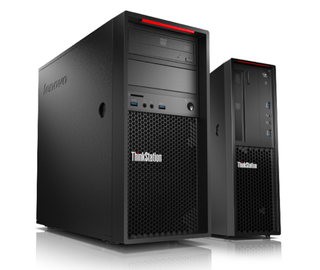Lenovo Unveils ThinkStation P300 in SFF and Tower Form
Lenovo's new ThinkStation P300 ditches the carry handle and is available in two different form factors.

Alongside its new tablet offering, the ThinkPad 10, Lenovo today unveiled a brand new desktop workstation called the ThinkStation P300. Available in both tower and small form factor models, this is an entry-level workstation with the sleek black lines and red accenting we've come to expect from any product carrying the company's 'Think' branding.
Lenovo is targeting businesses looking to upgrade PCs without breaking the bank. The bottom line is high-performance on a budget. Under the hood you're looking at Intel's Core i3, i5, i7, or Xeon E3-1200 processors along with up to Nvidia Quadro K600 in the small form factor or up to Nvidia Quadro K4000 in the tower. There's also support for up to 32 GB of memory (four slots); room for 3x HDD (two 3.5-inch and one 2.5-inch) in the SFF or 4x HDD in the tower (four 3.5-inch or four 2.5-inch); and 24 GB, 128 GB, and 256 GB via mSATA. Inside there's 1x PCIe x16, 1x PCI x4, 1x PCIe x1, and 1 PCI. Portswise, up front you have 2x USB 3.0, 1x mic, 1x headphone, and 1x SD card reader. In the back, there's 4x USB 3.0, 2x USB 2.0, 1x Serial, 1x VGA, 2x Display Port, 1x Ethernet, 1x audio line in, 1x audio line out, and 1x mic in. There's also optional Firewire, 29:1 MCR, eSATA, and Serial. The small form factor model measures 4.0 x 14.8 x 13.3 inches, while the tower rings in at 6.9 x 16.97 x 16.7 inches.
Pricing for the ThinkStation P300 will start at $729, though obviously higher-end configurations will jack the price up higher than the baseline price Lenovo is dishing out today. Availability is set for June via Lenovo business partners and on www.lenovo.com.
Follow Jane McEntegart @JaneMcEntegart. Follow us @tomshardware, on Facebook and on Google+.
Stay On the Cutting Edge: Get the Tom's Hardware Newsletter
Get Tom's Hardware's best news and in-depth reviews, straight to your inbox.
-
Lutfij Its good to see Major Brands opting towards SFF systems. A couple of years ago, the idea of compact systems were seen mostly in non powerhouse systems and office spaces and not in the professional environment.Reply
I wonder if anyone needs an optical drive anymore though. Design wise that would just free up a bay drive and make room for a card reader.
Most Popular



